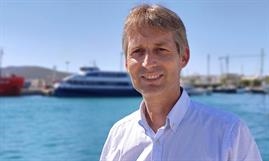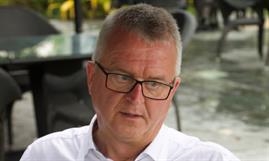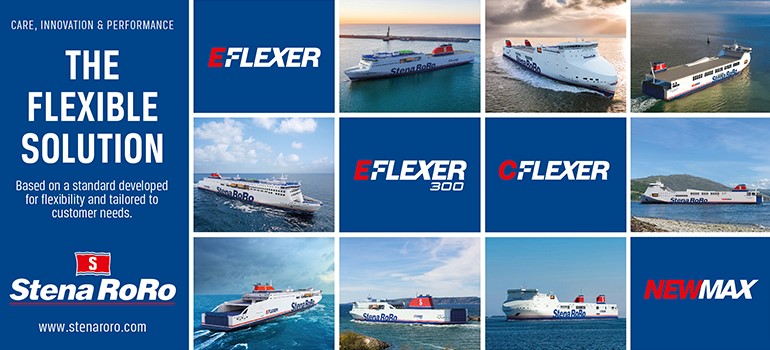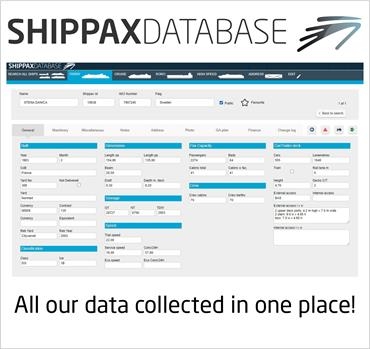
Clément Mousset and Cedric Rivoire-Perrochat
CMV FRANCE – PROPITIOUS BIRTH OF A NEW BRAND FOR FRENCH-SPEAKING CRUISE MARKET
InterviewIn the last few years, Clément Mousset and Cedric Rivoire-Perrochat, two veterans of the French cruise industry, have been busy working on the creation of a new cruise line in France. The project, initially named Compagnie des Croisières Françaises (CCF), eventually emerged in November 2019 as Croisières Maritimes et Voyages (CMV France), a Frenchification of Cruise & Maritime Voyages (CMV).
Targeting the French-speaking market, the new brand is a subsidiary of the UK-based CMV group. From April 2021, it will set sail on the 1987-built JULES VERNE (formerly ASTOR), which currently is being customised and adapted for the French market. Clément Mousset serves as managing director of the new company. He has more than 20 years of experience working for major international cruise lines – including Festival Cruises, Costa Crociere, and Royal Caribbean – at various levels in France. Cedric Rivoire-Perrochat occupies the position of manager of operations, marketing and communications. He began his cruise industry career more than 25 years ago, fulfilling various shoreside and onboard positions. His portfolio includes working for several US-based cruise lines, such as Royal Caribbean, Celebrity Cruises, and Norwegian Cruise Line. He also spent four years at CLIA France, in charge of institutional relations and the travel agent programmes. Mousset and Rivoire-Perrochat spoke to Shippax recently about their insight into the French-speaking cruise market, their inspiration and aspiration for the new company.
Shippax: In a nutshell, what, in essence, is Croisières Maritimes & Voyages (CMV France)?
Clément Mousset (CMO): We founded Compagnie des Croisières Françaises and went on to form the most beautiful partnership ever with Cruise and Maritime Voyages. CMV now owns 100% of CCF, which has become Croisières Maritimes & Voyages or CMV France. Our management team consists of 16 members; one of them is based at the CMV’s head office in Purfleet, UK. We expect to welcome 10,000 passengers in 2021 and this figure will continue to grow in the coming years.
Cedric Rivoire-Perrochat (CRP): On the global level, as a group, CMV’s workforce comprises of 4,000 employees. It carried nearly 150,000 guests in 2019. The partnership offers us all the necessary experience and expertise to take on the challenges in the French-speaking markets, which consists mainly of France, Belgium, Switzerland, Luxembourg, and Quebec. In terms of marketing and sales, we can also rely on the IT tools developed in-house by CMV, such as the booking system. One of our objectives is to achieve a controlled growth with a product that is distinctly different from what is currently available on the French-speaking cruise market.
Shippax: How did the idea of a French-speaking-market-focused cruise line come about? Why did you decide to enter partnership with CMV?
CMO: While working on the CCF project, we soon came to realise that finding investors was more challenging than we had imagined. Two years were not long enough to convince potential partners that our cruise business model would be a success and, above all, a promising one. Only operators with knowledge of the international market could understand our approach. CMV, which had been present in France for several years through the chartering of the 1948-built ASTORIA, understood better than anyone else our desire to conquer the French market. Our initial meeting confirmed our desires to work together. This was the beginning of a great adventure.
CRP: What struck us was a general lack of understanding of the cruise industry. The product certainly has its appeals, but it also frightens French investors. Subsequent meetings with CMV were fruitful. Their knowledge of the market combined with our project vision, which was perfectly in line with their own concept, only served to confirm the obvious – we had all the necessary ingredients to jointly develop a product dedicated to French-speaking markets.
Shippax: What did you learn from your analysis of the French-speaking markets that supported the creation of this company? Who will be the target passenger?
CMO: The analysis is simple and I know that some of my cruise industry colleagues won’t like it. But, let’s face it, if the cruise industry wants to continue expanding in France, the current monopoly of the two major protagonists – MSC Cruises and Costa Crociere – will not serve this purpose well. The more numerous the players like CMV, with smaller capacities and dedicated to the specialised market, the more the industry will grow. This is not a new idea; one just needs to look at the biggest national source markets, such as USA, UK, Germany, and Australia, to understand what really drives the industry’s expansion.
Since the demise of Croisières de France, Royal Caribbean International’s subsidiary for the French market in 2017, France has lost 100,000 cruise passengers; yet, at the same time, vessels of major brands deployed on the French market are constantly getting larger. How can this contradiction come about? I believe the existing offer has not tapped into a major part of the market. There is room for everyone. With a target of 10,000 passengers per year, CMV France does not aim to become the market leader. Our ambition is modest: we want to revive the passion for ocean travel in the French-speaking markets.
CRP: We conducted market researches as part of the initial CCF project. Not everything was based purely on our imagination. We had to have an empirical basis, upon which to develop our business and strategies. We studied different scenarios, with different sizes of vessels, the largest being not exceeding 1,400-passenger capacity. Our studies supported what we had been hearing for some time. Mega liners certainly have their established clientele base, such as families; but many potential customers, mainly experienced and first-time cruise guests, don’t want to go on these giant vessels. They consider them as impersonal. They want to travel on smaller ships. We didn’t want to compete directly with major mass-market players. This was why, and from the outset, we opted for longer cruises and always departing from French ports. This would mean no flights required for our customers.
Our cruise programmes, with an average duration of more than 12 nights, have a wider target audience. They appeal to 55-year-olds and solo travellers of middle and upper socio-economic backgrounds. Given its size and an absence of dedicated facilities, JULES VERNE is not suitable for families. However, we have four sailings that welcome families with children.
Shippax: CMV started operation with one ship ten years ago. Today, its fleet consists of seven ships. How would you explain this success?
CMO: What has been achieved in France in the last 25 years has been the effort of mainly one cruise line – Costa. And we can only thank them for that. But, to grow further, the market needs the presence of diverse, varied, and national operators. This is the perfect alchemy that CMV has been able to attain in the United Kingdom, in Germany through its subsidiary TransOcean, and in Australia. Success means listening to customers, respecting their wishes, and, above all, offering them what they expect – a maritime experience in an intimate surrounding where guests feel at home. This is the secret of CMV’s success.
CRP: Many cruise markets have expanded because of national fleets and brands, particularly those owned and operated by tour operators, as it has been the case in Germany, UK, and Spain. To follow up what Clément has just said, CMV’s success is also based on its concept of close-to-home departures and using smaller and older vessels that are far from being ‘floating cities’ we so often see today. From one vessel, the 1965-built MARCO POLO, the company has been able to build up a loyal and expanding clientele base from year to year. This has enabled CMV to expand its fleet while maintaining a measured and sustainable growth.
Shippax: Have you any perspective yet on how COVID-19 will affect your business and objectives or is it still too soon to tell?
CMO: Our operations will only begin on 29 April 2021. The COVID-19 pandemic so far has not directly impacted our schedule. It would be a lie to say that we were selling as many cruises as we had done in January. But we are still receiving some nice bookings.
Having sold six full round-the-world cruises in 15 days is not a negligible success in any context. We are following events closely and are impressed by our parent company’s excellent crisis management strategy throughout this pandemic.
CRP: We are fortunate to have an exceptionally large marketing window, with a 15-month period of promotions and sales before the first commercial sailing. Certainly, the current crisis has slowed the pace of bookings and some customers have postponed their purchase decisions until the lockdown has ended. But the interests in our cruises and our ship are definitely there. We can see them every day.
The CMV fleet has not recorded any case of COVID-19. Our sanitation procedures are of the highest standard and, as Clément has mentioned, we are closely monitoring the situation. There is no doubt that modifications and procedural changes will have to be made on board. Our efforts, guided by such institutions as World Health Organization, the USA’s Centers for Disease Control and Prevention, and the European Centre for Disease Prevention and Control, will enable us to be even more efficient and vigilant in the future in regard to health and safety of our crew and customers. As for the rest of the operations, how will the situation evolve with, for example, the schedule for port reopening, etc., it is still too early to tell.
Shippax: In the past, you highlighted that – unlike Croisières de France, which was managed from Spain by Pullmantur and USA by Royal Caribbean International – you had the full latitude to manage CMV France. Yet you will operate a ship you don’t directly own. Is there a risk that, at some point, the parent company may take it back if, for instance, there is a need for capacity elsewhere?
CMO: It is not our intention to enter and then leave the French-speaking market. We know that it will take time and investment. There is an absurdity in the manner CDF departed from the French market. A company that didn’t lose money shouldn’t be sacrificed, especially after 10 years of profitable performances. For CMV, the French project is a long-term commitment. We have jointly agreed on a development plan that will allow us to keep JULES VERNE for a number of years, without even the option of replacing it with another vessel. Its removal will only take place after the introduction of a second ship, not before. We have received confirmation of this from our parent company.
CRP: JULES VERNE is an ideal vessel to launch such a project, as it allows French-speaking guests to renew and rediscover the pleasure of cruising and exploring new destinations sustainably. It will enable us to establish our brand and build loyalty among our customers who are in search of affordable authenticity. This relationship of trust is also based on the durability of Croisières Maritimes & Voyages as a brand. Development projections are already made for a number of years ahead. JULES VERNE has a great potential and has been modernized several times over its lifetime.
Shippax: Most of the ships deployed on the French-speaking market, even though not of the same size, were built after 2000. In Europe, in general, and in France, in particular, the question concerning the ecological impact of cruise ships is frequently asked. How would you respond to the accusation of ships like JULES VERNE being environmentally unfriendly?
CMO: Again, the public’s lack of knowledge of the cruise industry is overwhelming. The problem with the media reports of the last few years was that they were all about costs, without really understanding the why and the how. JULES VERNE is a very small vessel in the universe of the big ships. Even though it is 30 years old, it perfectly meets the environmental standards required by all the ports it calls in. Its size is about 11.5 times smaller than the largest cruise ships in the world. I do not need to tell you how much less it pollutes. Rather than burning 0.5% sulphur content fuel, CMV has chosen to burn 0.1% sulphur content fuel as used in SECAs, regardless of where JULES VERNE will operate. That is five times lower than the level required by IMO outside of SECA zones. This represents a considerable investment to us.
CRP: The company’s approach to environmental issues was established at its inception. All vessels in the fleet are drydocked annually for live-work maintenance/adaptation of shipboard systems. Very few companies make this annual investment. Most shipowners perform maintenance of this extent every three to five years, depending on the vessel. It is also important to note that JULES VERNE consumes far less fuel than do the large cruise ships, which need to power a wide range of new features on board. Our ship has no ice rink, water park, or other fancy facilities that need to be supplied with power constantly. Moreover, we have designed our itineraries based on an average sailing speed of 13 knots in order to reduce fuel consumption and therefore the ecological impact, using a low-sulphur fuel, as Clément has just mentioned. This is only the visible part. Beyond that, our onboard environmental impact reduction procedures are very strict.
Shippax: You expect to begin operations in spring 2021. Where will be JULES VERNE’s homeports? Can you give us a sneak peek of the itineraries you plan to sell?
CMO: Offering no fewer than 15 ports of embarkation, the CMV UK model impressed us from our very first meeting. The maximum distance between a CMV customer and a port of embarkation is 250 kilometres. It is remarkable for a company of this size to be able to offer all its customers embarkation ‘from home’.
We’re not there yet. But in France we can now offer two main ports of embarkation and disembarkation – Marseille and Le Havre. We chose Marseille to establish the headquarters of our company because it was essential for us to be at the heart of the action. We also designated Le Havre as a homeport because we wish to revive the great tradition of French-style cruising. No other port can do better than Le Havre in helping us to make this dream come true. In 2021, other French ports will also welcome JULES VERNE and, during special calls in Bordeaux and Dunkerque, passengers will be able to embark and disembark. In the first year of operation, no fewer than four French ports will welcome our passengers at the beginning and the end of the cruise.
CRP: The notion of proximity departures is at the heart of our strategy. And the choice of our homeports was obvious, as Clément mentioned. Le Havre, offers us many seven-to-fourteen-night Northern Europe itinerary options. We will sail to the Baltic, via the Kiel Canal because JULES VERNE is small enough to take advantage of this passage; we will overnight at Saint Petersburg, as well as visiting the North Cape, Ireland, and the British Isles. Marseille is the obvious choice for the five-to-sixteen-night Mediterranean cruises. We wanted a varied programme, ranging from the Atlantic islands to the Black Sea, Holy Land, and Egypt. All of our itineraries have been designed to allow our guests, who wish to do so, to combine up to five different cruises without visiting the same ports. And our most ambitious ‘Round the World Cruise’ will depart Marseille on 8 January 2022. After rounding the two great capes of the Southern Hemisphere, the ship will arrive back in Le Havre on 11 May. All 100% French-speaking, of course. We are currently finalizing the 2022/23 programmes, which will include many new features and new destinations.
Shippax: Are you already working on expansion plans?
CMO: When one works on launching a company like ours, one doesn’t plan for the short term. We have indeed planned for the introduction of a second ship in 2023-24. But, in the immediate future, with JULES VERNE, we are already offering our French-speaking guests the unique Croisières Maritimes & Voyages cruise experience. We will win the hearts and souls of French cruise passengers with gastronomy, service, and other traditional French flavours.
CRP: The success of a new company is forged over time. We are not in a hurry, but we are not lacking in ambition either. Our strategy is established for the long term and the arrival of a second unit in the French-speaking fleet will undoubtedly enable us to be even more audacious and imaginative in the destinations and itineraries we offer.
© Shippax / Bruno Jonathan
jul 01 2020
Most read
Carnival Corporation full-year results
dec 21 2025
Not a Merry Christmas for CMAL and CalMac as two newbuilding ferries – GLEN ROSA and ISLE OF ISLAY - are further delayed
dec 22 2025



















